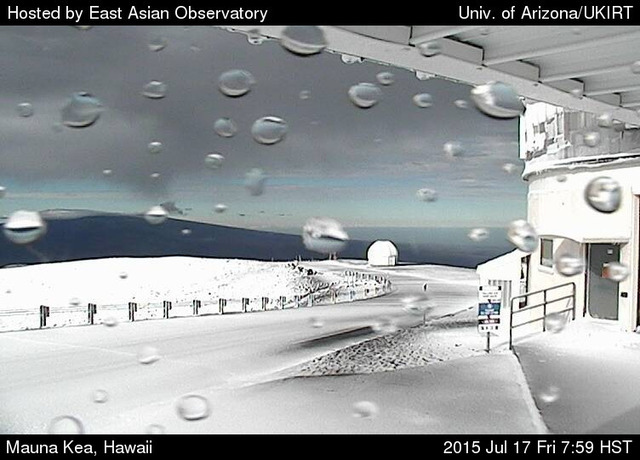Four days after reopening, following protests of the Thirty Meter Telescope, the Mauna Kea Access Road was shut down once again Thursday night.
Only this time it was snow and ice — an unusual sight in July — that forced the closure, instead of protesters and boulders.
Remnants of Tropical Storm Ela combined with low-level trade winds created chilly conditions that blanketed the summit of Mauna Kea on Thursday night with about 1.5 to 2 inches of snow, according to Ryan Lyman, a forecast meteorologist with the Mauna Kea Weather Center.
“It started getting to freezing about 9 p.m., (Thursday) night, just as the first bands of clouds started to roll in, and it stayed 1 degree Celsius (33.8 degrees Fahrenheit) for the rest of the night,” he said of conditions at the summit. “Then around 10 or 11, the light dusting began, which went throughout the night.”
The weather center’s website, mkwc.ifa.hawaii.edu, announced the summit road’s closure because of icy conditions at 5:55 a.m. Friday.
“After road inspection this morning, the ranger reports ice on the upper summit ridge and switchback, the east/west summit ridge … ,” the bulletin reads. “He also reported mixed rain and snow, fog (and) there is an inch-and-a-half of frozen snow on the summit and moderate winds.”
As of 3 p.m. Friday, the road remained closed because of ranger concerns about black ice.
“The rangers are charged with inspecting the road. It’s their call,” said University of Hawaii spokesman Dan Meisenzahl. “They saw there was a lot of black ice they deemed dangerous. They’ve been inspecting every hour or so waiting for it to burn off. It could very well reopen in the next few hours when all is said and done.”
Lyman said while snowfall in July atop Mauna Kea is rare, it is not unheard of.
“In the last 13 years, I can only recall one other time (when it snowed),” he said. “And a few years ago, we had another (snowfall) in June. We’re in the middle of a strong El Niño right now, but it could happen any year.”
Even a spate of record-setting high temperatures wasn’t enough to keep the snow at bay, he added. Clear, sunny days might make temperatures warmer at the summit during the day, but in the evening when the sun goes down, the cinder that makes up most of the landscape radiates its heat into the air rapidly, providing a welcoming surface for snow to stick.
“All you need is moisture and temps near freezing. It’s not going to take much to get snow all the way up there,” Lyman said.
Now that the rain passed, the white peak at the mountaintop won’t last long.
“It’ll probably melt by the end of (Saturday),” Lyman said. “We really expect things to go down quickly.”
Kahookahi Kanuha, a protest leader and one of several who has been living on the mountain for nearly four months in a stance against the $1.4 billion TMT, said the unusual weather was not a coincidence, but a sign.
He said he and other protesters are not lying when they speak of Mauna Kea as being sacred and the realm of Poli‘ahu, the Hawaiian goddess of snow, ice and cold.
“How normal is it to have snow in Hawaii in the middle of July?” Kanuha asked. “We’re talking about the hottest month of the year.”
“I think that this is an answer and confirmation of our pule (prayer) … I think it’s meant to be.”
Email Colin M. Stewart at cstewart@hawaiitribune-herald.com.



